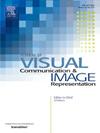基于骨架Insight纵横网络的可见-红外人再识别算法
IF 2.6
4区 计算机科学
Q2 COMPUTER SCIENCE, INFORMATION SYSTEMS
Journal of Visual Communication and Image Representation
Pub Date : 2025-01-28
DOI:10.1016/j.jvcir.2025.104395
引用次数: 0
摘要
跨模态特征空间存在显著的类间差异。如果将行人骨架信息作为跨模态人再识别的判别依据,不可避免地会出现骨架特征与身份属性不匹配的问题。为了解决上述问题,本文提出了一种新型的骨架洞察纵横网络(SI-CCN),该网络由骨架洞察模块(SIM)和纵横模块(CCM)组成。前者利用骨架分层机制提取行人肢体区域的关键骨架信息,获得骨架关键点在像素级的特征,并将骨架关键点作为图节点构建行人的骨架姿态结构;因此,SIM模块不仅可以准确捕捉行人各部位的空间信息,还可以保持骨架各关键点之间的相对位置关系,形成完整的骨架结构。后者通过交叉学习机制协同优化高维骨架和低维身份识别的特征。为了有效捕获不同的骨骼姿态,在特征提取过程中动态调整两者的注意力分布,同时融合身份细节,提高跨模态特征的一致性。在SYSU-MM01和RegDB两个跨模态人再识别数据集上的实验表明,SI-CCN在SYSU-MM01数据集上的Rank-1和mAP分别为81.94%和76.92%,在RegDB数据集上的Rank-1和mAP分别为95.49%和95.67%。与已有的代表性方法相比,该方法具有更好的性能。本文章由计算机程序翻译,如有差异,请以英文原文为准。
A Visible-Infrared person re-identification algorithm based on skeleton Insight Criss-Cross network
There are significant inter-class differences in the cross-modal feature space. If the pedestrian skeleton information is used as the discrimination basis for cross-modal person re-identification, the problem of mismatch between the skeleton features and the ID attributes is inevitable. In order to solve the above problems, this paper proposes a novel Skeleton Insight Criss-Cross Network (SI-CCN), which consists of a Skeleton Insight Module (SIM) and a Criss-Cross Module (CCM). The former uses the skeleton hierarchical mechanism to extract the key skeleton information of the pedestrian limb area, obtain the characteristics of the skeleton key points at the pixel level, and the skeleton key points are used as the graph nodes to construct the skeleton posture structure of the pedestrian. And as a result, the SIM module can not only accurately capture the spatial information of various parts of the pedestrian, but also maintain the relative positional relationship between the key points of the skeleton to form a complete skeleton structure. The latter cooperatively optimizes the characteristics of high-dimensional skeleton and low-dimensional identity identification by using a cross-learning mechanism. In order to effectively capture the diverse skeleton posture, the attention distribution of the two in the feature extraction process is dynamically adjusted to integrate identity details at the same time, and the consistency of cross-modal features is improved. The experiments on the two cross-modal person re-identification data sets of SYSU-MM01 and RegDB show that the Rank-1 and mAP of the SI-CCN on the SYSU-MM01 data set are 81.94% and 76.92%, respectively, and the Rank-1 and mAP on the RegDB data set are 95.49% and 95.67%, respectively. The proposed method has better performance than that of the recent representative methods.
求助全文
通过发布文献求助,成功后即可免费获取论文全文。
去求助
来源期刊

Journal of Visual Communication and Image Representation
工程技术-计算机:软件工程
CiteScore
5.40
自引率
11.50%
发文量
188
审稿时长
9.9 months
期刊介绍:
The Journal of Visual Communication and Image Representation publishes papers on state-of-the-art visual communication and image representation, with emphasis on novel technologies and theoretical work in this multidisciplinary area of pure and applied research. The field of visual communication and image representation is considered in its broadest sense and covers both digital and analog aspects as well as processing and communication in biological visual systems.
 求助内容:
求助内容: 应助结果提醒方式:
应助结果提醒方式:


